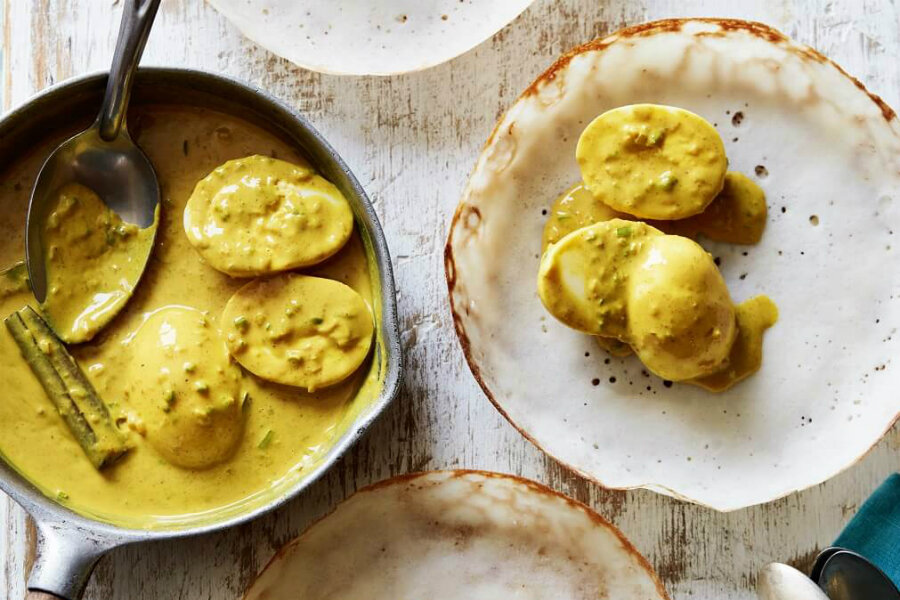Cooking with coconut
Loading...
Before I discovered coconut milk in a can, there was the coconut auntie at the wet market.
One whiff of coconut and I’ll be transported to the neighborhood wet market where I grew up in Singapore. Once a week, usually a Saturday, I’d accompany my mom on her weekly grocery run. After buying meat, fish, and vegetables, our last stop was usually the coconut stall.
The coconut stall auntie (for some reason we called all the stall-owners “auntie” or “uncle”) would run chunks of brown coconut through her machine, basically an industrial-sized grater, and piles of fluffy snow-like flakes would pop out the other end. She would scoop a bowlful or two into a clear plastic bag and hand it to my mom. (Here’s a link to a video.)
At home, my mom would combine the grated coconut with water and squeeze out the milk once, then twice. The first squeezing produced thick coconut milk, and the second squeezing, thin coconut milk. Both were used in everything from savory dishes like curries and stews to sweets and drinks like steamed cakes and es teler (kinda like an Indonesian halo halo).
Coconut milk has always been a huge part of my diet, much more so than cow’s milk. So you can imagine my delight when I found out about Ramin Ganeshram’s new cookbook "Cooking with Coconut–125 Recipes for Healthy Eating; Delicious Uses for Every Form: Oil, Flour, Water, Milk, Cream, Sugar, Dried; Shredded (Storey Publishing, December, 2016)."
(Disclosure: Ramin was my instructor for a food writing class I took eons ago!).
In her book, Ramin writes that coconut is native to tropical climates and is a staple ingredient in the cuisines of South Asia, the Caribbean and Southeast Asia (that’s my tribe!).
In the United States, the Southern colonies were the first to encounter coconut. Whole mature coconuts arrived on trade ships also bringing sugar, spices and slaves from the Caribbean, and coconut was used only sparingly (think coconut cream pie). It wasn’t until the early 20th century (1900s) when entrepreneur Franklin Baker Sr., who owned a flour milling outfit, had a ship’s hold full of fresh coconuts and no buyers. Caught in a bind, Baker figured out a way to dry and grate the white-fleshed coconuts before they spoiled and gave the flakes away to home cooks and chefs to try. Needless to say, they were a hit and this changed the future of coconut and baked goods in the US. Today, you can find Baker’s product stocked on any supermarket’s shelves as Baker’s Angel Flake Sweetened Coconut.
Coconut in its various forms – water, milk, chips, shreds, sugar, oil, molasses, vinegar, flour etc. - is no longer considered exotic in the US. Coconut is versatile and easy to adapt to the modern kitchen. Coconut is also a tropical super-powerhouse of nutrients. It definitely deserves a place in your pantry.
Here is a sampling of the products you can find at North American stores:
Dried coconut is the meat from mature brown coconuts that has been further dried. It is sold in packages shredded, diced, flaked, sweetened, and unsweetened. Sweetened flaked coconut is commonly used for baking.
Coconut water is found in the center of the coconut, and is more abundant in young or green coconuts. In some cultures, coconut water (not Gatorade!) is used as an electrolytic drink to prevent dehydration.
Coconut milk is the smooth liquid that’s pressed out when coconut meat and water are combined/pureed and strained. The less water used, the thicker and creamier the milk.
You’ll find coconut milk most often in shelf-stable cans which comes in lite (reduced fat) and full fat. Shake the can before use or shake it to mix the thicker cream with the thinner milk below.
Coconut milk in refrigerated cartons is considered a nondairy beverage and can be found next to the soy and almond milks in the supermarket. Flavoring, sweetener and carrageenan are usually added. I’d use this form more for drinking than cooking, and perhaps some baking.
My latest find is coconut milk in Tetrapaks. These shelf-stable cartons are similar to canned milk and come in small packs for a single use.
Coconut Cream results from processing coconut meat with very little water. The cream separates and rises to top. In the Caribbean, coconut cream is sold in blocks like butter and thinned with hot water to make the desired consistency.
Coconut nectar or molasses has a low glycemic index like agave and is becoming more popular. After the coconut palm tree is tapped, the sap is heated at a low temperature to thicken. The viscous liquid is then used as a sweetener.
Coconut flour is defatted coconut meat dried and ground into flour. It’s derived from the solids leftover from the process of making coconut milk and can be a substitute for all-purpose flour.
Coconut sugar is popular because of its low glycemic index. It is also a sap-based product but this time, the heavy branches growing coconut blossoms are tapped for the milky white sap they hold. The sap is boiled at a low temperature until it granulates into sugar crystals. The process is similar to transforming cane juice into granulated sugar.
Macapuno or coconut sport is a must in the Filipino dessert halo halo. Sometimes jokingly called “mutant coconut” or “freak coconut,” macapuno is a genetic anomaly. Instead of coconut water (it may have a little), a macapuno coconut contains a gelatin-like substance that’s scraped out in shreds. The shreds are cooked, turning them translucent, and preserved in jars with syrup and used for candies, pastries and ice cream.
Coconut vinegar is made from the sap that’s produced from tapping coconut blossoms. Because coconut trees are typically grown in extremely nutrient-rich soil, the blossoms are packed with everything from amino acids to vitamins B and C, fiber, and inulin, a naturally occurring prebiotic for digestive health.
Now that you have some coconut background, you’ve got to try out some recipes! I’m happy to share Ramin’s “Sri Lankan Hoppers and Egg Curry” below but if you want to explore coconut’s infinite possibilities as an ingredient – sweet, savory, and sippable – "Cooking with Coconut" is your go-to tome. Packed with an assortment of global recipes including Thai, Indian, Filipino, Vietnamese, and many Caribbean cultures, This cookbook also contains some new/fusion recipes that Ramin cooked-up.
I must admit I chose this recipe partly because of the cute name (who wouldn’t want to try a hopper?)! Also known colloquially as appam, hoppers are Sri Lankan pancakes, often eaten for breakfast or as a snack. Sometimes, a splash of toddy (palm wine) is added to the batter for a sour tinge. Hoppers can be eaten with curry, as with Ramin’s recipe, sambal (a chili paste made with onions and other stuff) or simply enjoyed with salt and pepper.
Sri Lankan Hoppers with Egg Curry
For the hoppers:
1 teaspoon active dry yeast
1 tablespoon plus 1 teaspoon sugar
1 cup warm water (110°F/45°C), or more as needed
1 cup rice flour
1/4 teaspoon salt
1 cup coconut milk, at room temperature
Coconut oil for frying
For the egg curry:
1 tablespoon coconut oil
1 shallot, minced
5 fresh curry leaves
1/2 teaspoon Maldive fish flakes or fermented shrimp paste
1/2 teaspoon chili powder
1/2 teaspoon ground cumin
1/2 teaspoon ground turmeric
1 green chile, minced
1 cup coconut milk
1 small cinnamon stick
6 hard-boiled eggs, sliced in half lengthwise
1 teaspoon salt
Directions:
- To make the hopper batter, stir together the yeast, 1 teaspoon of the sugar, and 1/4 cup of the warm water in a large bowl. Let sit until the mixture begins to foam and bubble, about 2 minutes.
- Stir in the rice flour, salt, and the remaining ¾ cup water and mix well until the batter is smooth. Set aside to rise in a warm spot, covered with plastic wrap, overnight. It should double in size.
- To make the egg curry, heat 1 tablespoon coconut oil in a medium saucepan over medium-low heat. Add the shallot and fry until it begins to soften, 1 minute. Add the curry leaves and fry until they begin to blister, 30 to 40 seconds, then stir in the fish flakes and fry, stirring, for 1 minute. Stir in the chili powder, cumin, turmeric, and green chile, and fry for 30 seconds.
- Add the coconut milk and cinnamon stick, bring to a simmer, and cook until the mixture begins to thicken, about 10 minutes. Add the hard-boiled eggs and the salt and simmer 10 minutes longer.
- While the curry is cooking, fry the hoppers: Mix the coconut milk and the remaining 1 tablespoon sugar into the risen batter. The batter should be thinner than pancake batter. Add lukewarm water, as needed, to achieve this consistency.
- Heat a small wok over medium-low heat and brush with coconut oil. Pour about 1/4 cup of batter into the pan and swirl it around so the batter thinly coats the bottom and sides of the pan. Cover the pan, allow the crêpe to cook for 1 minute, then gently remove from the pan. Repeat with all of the batter. Serve hot with egg curry spooned into the center of the hopper.
Notes: Excerpted from Cooking with Coconut, © by Ramin Ganeshram, photography by © Matt Armendariz, used with permission from Storey Publishing. Cooking the hoppers in a mini wok gives them their distinctive bowl shape but a small frying pan will do!






